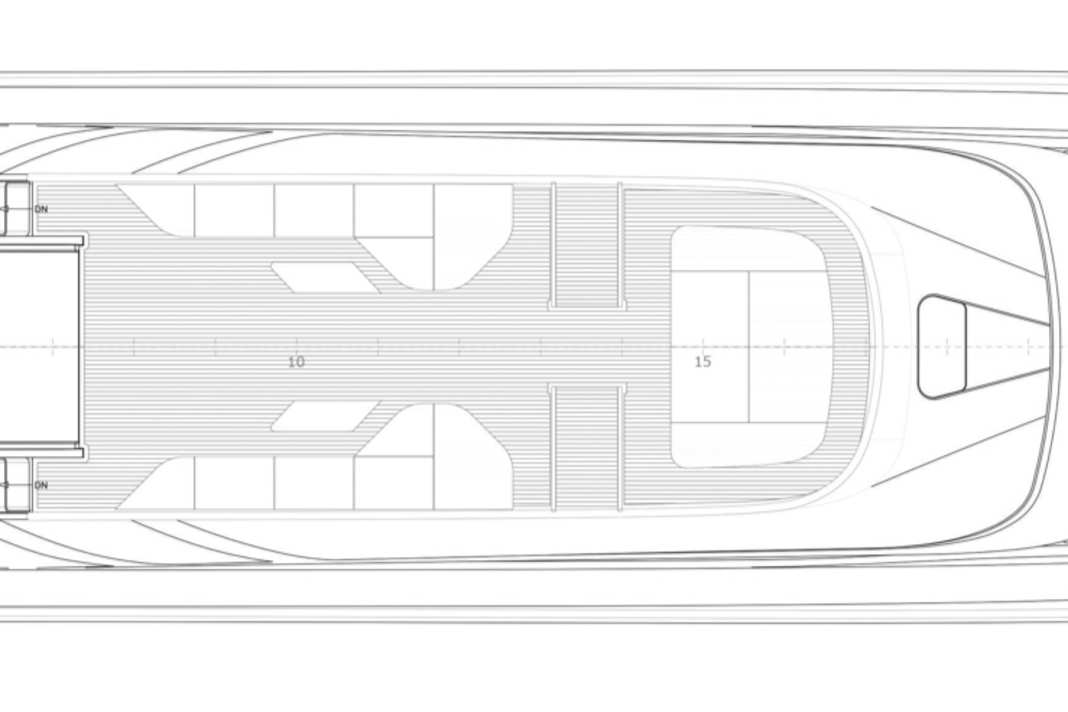





At first glance, they don't quite seem to fit in with a power format, the forward-sloping discs. Instead, they have become a trademark of Explorers, a striking expression of forward robustness. As the negatively inclined discs come from commercial shipping, they are of course more than that and offer many practical advantages. There are the rough water aspects: Splash water runs off more quickly on the outside, while the instruments are in the shade on the inside. In addition, the light is refracted, resulting in less reflection and glare. You won't find a windscreen on the AB 110, but there are two windscreen wipers hanging discreetly under the projection of the fly.
More space on the upper deck of the AB 110
The windscreen, which faces the wind at an angle, and the use of ultra-light, partially three-dimensionally curved glass with higher thermal resistance are intended to reduce the heating of the interior. The developers at the Next Yacht Group, the corporate home of the powerboat brand, were concerned with another aspect: maximising the deck area under the sun. Sales Manager Giacomo Benelli welcomes you to the top deck and backs up the seemingly style-breaking trick with figures: "For this yacht, we deliberately opted for the inverted, forward-sloping window to gain 40 per cent more space on the upper deck."
Of course, the 33.70 metre long glider flexes its muscles elsewhere, as befits a fast and agile waterjet format. It is the first model in a new series and closes the gap between the 130 and 100 models, with the shipyard's own team of exterior designers retaining the bulging superstructure panelling with the typical slits at the stern. With an AB, you want to pick up speed and be fast, just for fun or to be the first in the anchor bay or to spontaneously set off for the beach club on the neighbouring island.
Three diesel generators power the impellers
A trio from MAN's 2000 series serves as the energy source for the pumps for suctioning and the impellers for ejecting the water. Three water jet units, of which the outer ones control and the centre one acts as a booster. The configuration only provides a power boost for the European market in the form of MTU's 2600 series units, which cannot be fitted with a catalytic converter for customers from the USA. Regarding the top speed of the 110-tonner, Benelli says: "Optimally trimmed and without fouling, 43.5, almost 45 knots are possible. The AB 110 can easily manage between 40 and 41 knots."
"Even more important is the ride comfort, the boat runs very smoothly. And that is the DNA of AB yachts. Perfect relaxation is achieved at 38, 39 knots." Benelli is referring to the cruising speed, which, as is usual for the waterjet format, is extremely high and takes guests up to 430 nautical miles with full tanks. It's like a marathon runner's endurance sprint, because if you compare fuel consumption to the nautical mile and not the hour, the AB models are champions of efficiency.
Another advantage of the waterjet drive is the draught of just 1.30 metres, which owners can make full use of off Miami or in the Bahamas, for example. The USA is a traditionally strong sales market for the shipyard from Tuscany and a good reason for the design: "Due to US regulations, we had to approach the development differently compared to the AB100," explains Giacomo Benelli. "We could no longer sell them there because an SCR catalytic converter has to be fitted if the cargo area is longer than 24 metres. But that would have extended the engine compartment by 2.50 metres." Due to the drastic measures to reduce nitrogen oxide emissions, the company had to abandon the idea of an "upscaled" AB 100 and opted for a new design instead.
The design also included a spacious tender garage in the stern. The transom opens upwards according to the principle of a pantograph door together with the central element of the bathing platform and the lounge sofa on it. The tender enters the stern of the boat like a marina, is hooked up and can be lowered back into the water when the winch is set. In addition to the tender, a jet ski and Seabobs, which otherwise often end up on the bathing platform, can be stored in the garage. The connecting element between the exterior and interior are the twin steps to the bathing platform and up to the fly, where the carbon-framed helmstand is only opened for manoeuvring. Benelli stands next to the staircase artwork and explains: "We developed the design with Marco Casamonti. The carbon staircase is laminated in one piece in a single mould." Casamonti co-founded the architecture firm Arcea Associati and is now the artistic director of the Next Yacht Group, which has its headquarters in Viareggio and to which Maiora also belongs.
Continuity via teak flooring and twin staircases
The influence of Casamonti and thus the new direction of the brand, which has been in existence for 30 years, is particularly noticeable in the interior. The interior and exterior are not easy to distinguish from each other, which is also due to the continued teak decking with grey joints. With the saloon doors pushed to the side, the open galley on the port side is almost an open-air cooking area or a drink is prepared at the organically shaped bar. In front of it, a blackwashed wooden table stretches the length of the room, while two lounge sofas without armrests invite you to linger. The window panes extend downwards to the height of the bar. Above them, partly curved LED strips create indirect lighting that snakes along the walls, illuminating the rooms discreetly and comprehensively.
Even in the lower deck areas, guests are accompanied on both sides by brightly grouted teak on the steps, which are similarly rounded as the outside stairs and nestle against the walls in coves. Down here, the AB 110 once again proves to be a space miracle, with the fullest of the four guest compartments located almost amidships in front of the engine room and complemented by a VIP cabin in the bow. The two compartments in between, with their respective Pullman berths, have a sleeping capacity of ten people. All have a high proportion of leather and Alcantara with metal mouldings. The built-in furniture is a sandwich construction with foam cores as the base and limed oak veneers on the outside. Everything that is saved in terms of weight in the interior results in more performance. A rule of thumb says: for one tonne less displacement, the top speed increases by one knot.
Accommodation for up to four crew members in two crew cabins is offered by the bow section, which is surprisingly voluminous for a glider - what brings sailing yachts quickly over the water surface and out of their own wave system also helps motorised formats.
Alternative sports version with a dynamic look
For those who don't like the Explorer aesthetic of the slanted front windscreen or like it a little faster with a more streamlined superstructure, AB has an "S" version of the AB 110. The sports version of the AB 110 is the result of the first collaboration with automotive specialist EXE Design and features a narrow profile and a cockpit bimini that extends out of the superstructure roof as a whole.
Comfort is never neglected by the speed specialists. In the 34-metre-long hull, which is laminated under vacuum with vinyl ester resin and Kevlar and glass fibres, the Italians install two gyro stabilisers from Seakeeper, each weighing 1.4 tonnes, whose flywheels rotate at 5,000 revolutions per minute and thus prevent slow rides from turning into rocking rides. The background music, which is not unimportant on an open-air format, is provided by ten powerful loudspeakers on the outside and seven on the inside. Anyone looking for a versatile Open with power, comfort and class will love the AB 110. The second construction number is being offered for sale via Superyachts Monaco for 15.65 million euros.
Technical data of the AB 110




- Length over everything: 33,70 m
- Width: 6,80 m
- Depth: 1,30 m
- Displacement (full): 110 t
- Large Tonnage: 178 Gross Tons
- Material: GRP, Kevlar
- Motors: 3 x MAN 2000
- Engine power: 3 x 1,471 kW
- Speed (max.): 45 kn
- Speed (travelling): 38 kn
- Range @ 38 kn: 430 nm
- Generators: 2 x 32 kW
- Fuel: 11.500 l
- Water: 2.000 l
- Navigation: Garmin
- Construction: Next Yacht Group
- Exterior design: Marco Casamonti
- Interior design: Marco Casamonti
- Class: RINA C
- Shipyard: Next Yacht Group, 2025
- Price: 15.65 million euros

